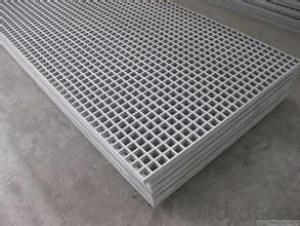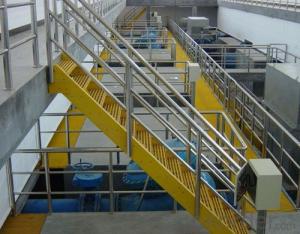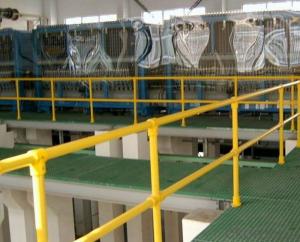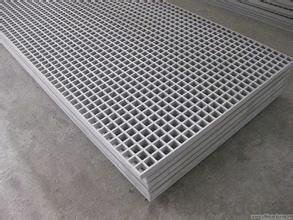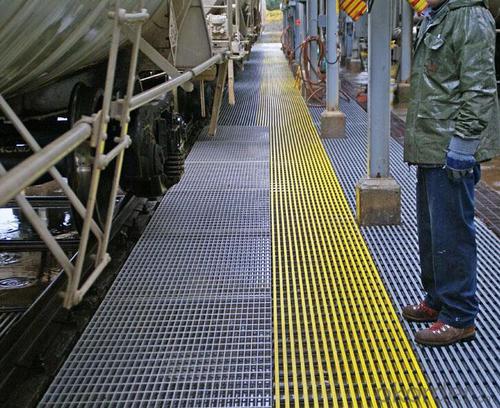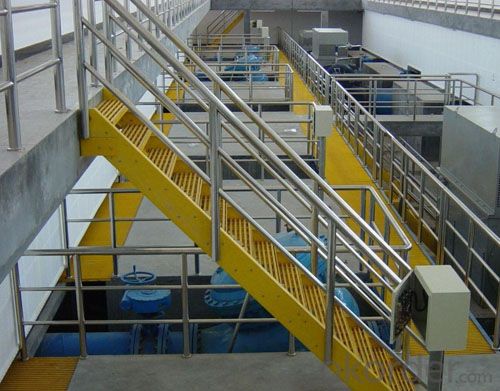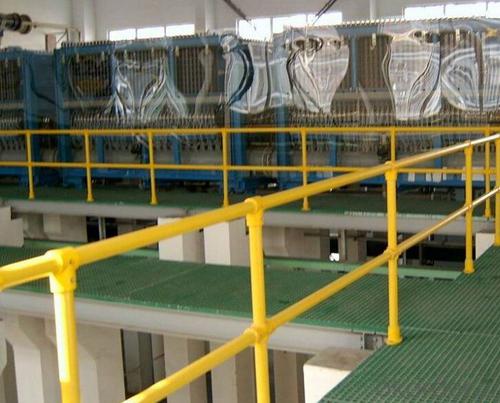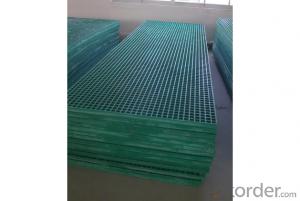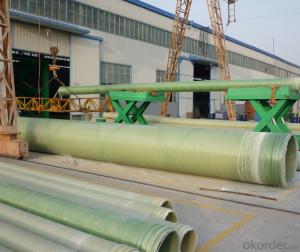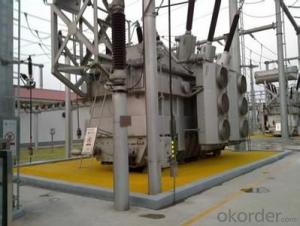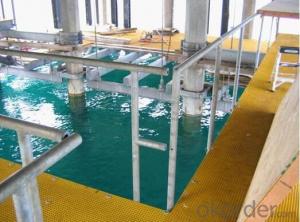FRP Pultrusion Profiles for Industrial Power Plant FRP Gratings Insulation
- Loading Port:
- Shanghai
- Payment Terms:
- TT OR LC
- Min Order Qty:
- 10 pc
- Supply Capability:
- 8000 pc/month
OKorder Service Pledge
OKorder Financial Service
You Might Also Like
Specification:
FRP molded grating made of vertical and horizontal continuous fiberglass fully soaked in unsaturated polyester resin giving perfect bi-directional mechanical properties. Combining unmatched corrosion resistance with strength, long life and safety, molded grating provide the ultimate in reliable performance, even in the most demanding corrosive conditions. Besides, it is easy to cut and install. CNBM offer the widest selection with panel sizes, colors and slip resistant surfaces, clients can avail FRP grating your specific requirements.
Product Features:
- Light but high loaded strength
- High anti-corrosion and anti-aging
- Easy installation and maintenance
- Low maintenance
- Non-conductive
- Lowest in life cycle cost
- Corrosion Resstance
- Anti-slippery
- Various sizes and color available
Colour Design:
To satisfy customer's design project, CNBM grating offers a wide selection of grating colors to choose from. The standard colors available for fiberglass grating as following:
- Blue
- Red
- Yellow
- Green
- Light Grey
- Dark Grey
Custom colors of fiberglass grating may be available upon request, you can contact us learn more.
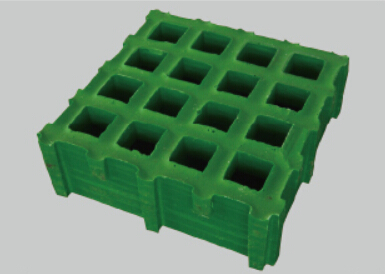
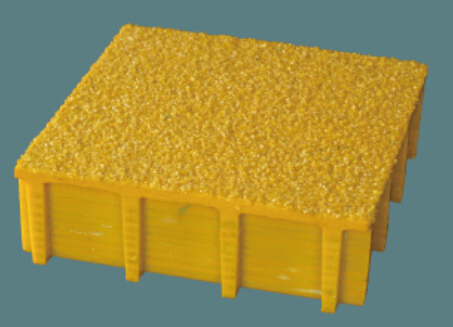
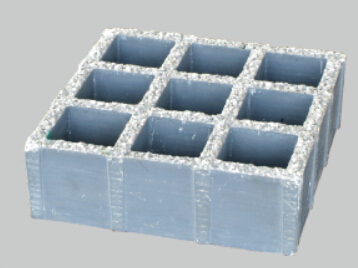
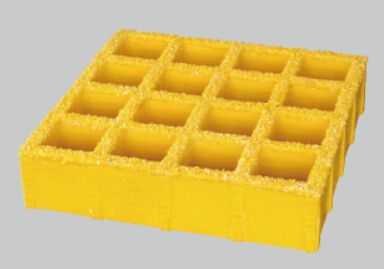
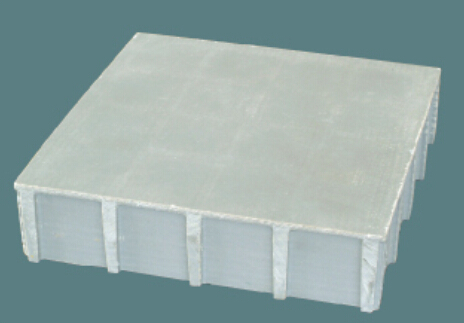
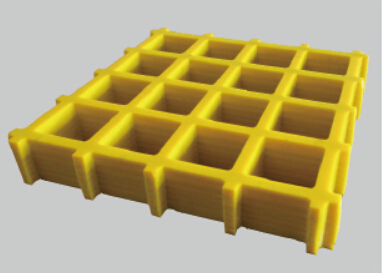
- Q: Are FRP pultrusion profiles resistant to chemicals used in pharmaceutical manufacturing?
- Yes, FRP pultrusion profiles are generally resistant to chemicals used in pharmaceutical manufacturing. The use of high-quality resins and fiberglass reinforcement in the manufacturing process makes FRP pultrusion profiles highly resistant to a wide range of chemicals, acids, and alkalis commonly used in pharmaceutical manufacturing. However, it is always advisable to consult with the manufacturer or supplier to ensure that the specific chemicals used in the manufacturing process are compatible with the FRP profiles.
- Q: Are FRP pultrusion profiles resistant to electrical arcing?
- Yes, FRP pultrusion profiles are highly resistant to electrical arcing due to their non-conductive nature, making them a safe choice for applications where electrical arcing is a concern.
- Q: Can not use glass steel support column, the main support for the door
- 1, glass steel toughness and carrying impact performance is strong, but the rigidity is relatively poor, that is, tensile, impact resistance is better, compressive performance is poor, so it is not suitable for props and other components.2, toughened glass is completely transparent, visual art, and the vertical stiffness is very large, excellent compressive strength, can be customized according to the needs of the processing of different thickness, if used to support the weight is not a big door can, but need to have the steel frame (outsourcing stainless steel).
- Q: Can FRP pultrusion profiles be used in the construction of amusement park rides?
- Yes, FRP (Fiber Reinforced Polymer) pultrusion profiles can be used in the construction of amusement park rides. FRP pultrusion profiles offer numerous advantages that make them suitable for such applications. Firstly, FRP pultrusion profiles are known for their high strength-to-weight ratio. This means that they are significantly lighter than traditional materials like steel while still maintaining excellent structural integrity. As a result, using FRP profiles in amusement park rides can help reduce the overall weight of the structure without compromising on safety. Secondly, FRP pultrusion profiles have excellent corrosion resistance properties. Unlike steel, FRP does not rust or deteriorate when exposed to moisture or chemicals commonly found in amusement park environments. This makes FRP profiles ideal for rides that are constantly exposed to water, humidity, and other harsh conditions. Additionally, FRP pultrusion profiles offer design flexibility. They can be manufactured in various shapes and sizes, allowing for customized designs to meet specific requirements of amusement park rides. This versatility in design enables engineers and designers to create complex and intricate structures that are both aesthetically pleasing and functional. Moreover, FRP pultrusion profiles have excellent electrical insulation properties. This is particularly important for amusement park rides that may have electrical components and wiring, as FRP profiles can provide a high level of safety by preventing electrical conductivity. Furthermore, FRP profiles are non-magnetic, which can be advantageous in amusement park rides that use magnetic systems or sensors. Non-magnetic materials eliminate the risk of interference or disruption to the ride's functionality. Lastly, FRP pultrusion profiles are durable and require minimal maintenance. They are resistant to UV radiation, which means they will not degrade or fade due to prolonged exposure to sunlight. This reduces the need for frequent painting or coating, resulting in lower maintenance costs over time. Overall, the combination of lightweight, corrosion resistance, design flexibility, electrical insulation, non-magnetic properties, and durability make FRP pultrusion profiles an excellent choice for the construction of amusement park rides.
- Q: Can FRP pultrusion profiles be used in the construction of train or subway platforms?
- Indeed, train or subway platforms can utilize FRP (Fiber Reinforced Polymer) pultrusion profiles. These profiles consist of a blend of reinforced fibers and a polymer resin matrix, endowing them with robustness and endurance. Their lightweight nature, resistance to corrosion, and exceptional mechanical properties make them suitable for diverse applications within the construction sector. Regarding train or subway platforms, FRP pultrusion profiles can serve as structural components, including handrails, guardrails, gratings, and decking systems. These profiles present a non-conductive and non-magnetic solution, crucial in railway environments to prevent interference with electrical and signaling systems. Furthermore, FRP pultrusion profiles offer a high degree of customization, enabling adaptation to specific project requirements. They can be crafted in various shapes, sizes, and colors to fulfill both aesthetic and functional demands in train or subway platforms. Moreover, FRP pultrusion profiles exhibit exceptional resistance against environmental factors such as moisture, chemicals, and UV radiation. This resistance ensures the profiles' durability and maintenance of their structural integrity over time, even in the harsh and corrosive conditions commonly encountered in railway environments. Overall, FRP pultrusion profiles represent a dependable and cost-effective choice for constructing train or subway platforms. They provide numerous advantages, including strength, durability, customization options, and resistance to environmental factors. Thus, they serve as a suitable alternative to conventional materials in these applications.
- Q: Are FRP pultrusion profiles resistant to high-pressure water jets?
- Yes, FRP (Fiber Reinforced Polymer) pultrusion profiles are generally resistant to high-pressure water jets. The inherent properties of FRP, such as its high strength-to-weight ratio, corrosion resistance, and durability, make it a suitable material for applications involving exposure to water and other harsh environments. The manufacturing process of pultrusion ensures that the fibers are thoroughly impregnated with resin, resulting in a homogeneous and highly dense composite material. This density provides FRP pultrusion profiles with a high resistance to water penetration, preventing the material from being damaged or compromised by high-pressure water jets. Furthermore, FRP pultrusion profiles are known for their excellent chemical resistance, which includes resistance to water. This characteristic ensures that the profiles will not degrade or deteriorate when exposed to high-pressure water jets over extended periods. It is worth noting that the specific resistance of FRP pultrusion profiles to high-pressure water jets may vary based on the specific resin and fiber combination used in their manufacturing. Therefore, it is recommended to consult the manufacturer or supplier for detailed information regarding the resistance of specific FRP pultrusion profiles to high-pressure water jets in a given application.
- Q: How do FRP pultrusion profiles perform in high humidity environments?
- FRP (Fiber Reinforced Polymer) pultrusion profiles perform exceptionally well in high humidity environments. The inherent properties of FRP, such as its corrosion resistance and moisture resistance, make it an ideal material for applications that are exposed to moisture or high humidity. One of the key advantages of FRP pultrusion profiles is that they are non-porous, which means they do not absorb moisture. This characteristic prevents the profiles from swelling, warping, or rotting when exposed to high levels of humidity. Unlike traditional materials like wood or steel, FRP does not degrade or lose its structural integrity in humid conditions. Additionally, FRP pultrusion profiles have a high resistance to chemicals, including the corrosive effects of moisture and humidity. This resistance to corrosion is due to the composite nature of FRP, which combines a matrix material (typically a resin) with reinforcing fibers, such as glass or carbon fibers. This combination provides excellent resistance to water and moisture-induced corrosion, ensuring the long-term performance of FRP profiles in high humidity environments. Furthermore, FRP pultrusion profiles offer excellent dimensional stability, even under extreme temperature and humidity variations. They do not expand or contract significantly, maintaining their shape and structural integrity in diverse environmental conditions. This stability makes FRP profiles suitable for applications in coastal regions, wastewater treatment plants, chemical processing plants, and other environments where humidity levels are high. Overall, FRP pultrusion profiles are specifically engineered to withstand harsh conditions, including high humidity environments. Their non-porous nature, resistance to corrosion, and dimensional stability make them a reliable and durable choice for various applications in humid climates.
- Q: Can FRP pultrusion profiles be used in chemical processing plants?
- Yes, FRP (Fiber Reinforced Polymer) pultrusion profiles can be utilized in chemical processing plants. FRP is resistant to corrosion, chemicals, and extreme temperatures, making it an ideal material choice in such environments. Additionally, FRP pultrusion profiles offer high strength-to-weight ratio and low maintenance requirements, making them suitable for various applications within chemical processing plants.
- Q: What types of materials are commonly used in FRP pultrusion?
- Fiber Reinforced Polymer (FRP) pultrusion is a manufacturing process that involves pulling continuous fibers through a resin bath and then through a heated die, resulting in a composite material with high strength and stiffness. Various types of materials are commonly used in FRP pultrusion, depending on the specific application and desired properties. 1. Fibers: The most commonly used fibers in FRP pultrusion are fiberglass (glass-reinforced polymer) and carbon fibers. Fiberglass is cost-effective, lightweight, and offers good strength and corrosion resistance. Carbon fibers, on the other hand, provide exceptional strength, stiffness, and lightweight properties but are more expensive. 2. Resins: The resin matrix used in FRP pultrusion provides the material with rigidity and protection against environmental factors. Polyester resin is the most common resin used due to its low cost, ease of handling, and good mechanical properties. Vinyl ester resin is another popular choice, offering improved chemical resistance and heat tolerance compared to polyester. Epoxy resin is used when high strength and durability are required. 3. Additives: Various additives can be incorporated into the resin matrix to enhance specific properties of the FRP pultruded product. UV stabilizers are commonly used to protect against ultraviolet degradation. Flame retardants can be added to increase fire resistance. Other additives like pigments, fillers, and mold release agents may also be used to achieve desired aesthetics and processing characteristics. By selecting the appropriate combination of fibers, resins, and additives, FRP pultrusion can produce a wide range of composite materials with tailored properties to meet specific application requirements. This versatility in material selection is one of the key advantages of FRP pultrusion, making it suitable for a variety of industries such as construction, infrastructure, aerospace, automotive, and marine.
- Q: Are FRP pultrusion profiles resistant to UV degradation?
- Yes, FRP pultrusion profiles are generally resistant to UV degradation. The combination of the materials used in pultrusion, such as fiberglass and resin, provides inherent UV resistance, making them suitable for outdoor applications where exposure to sunlight is a concern. However, it is always recommended to consult the manufacturer's specifications and guidelines to ensure optimal UV protection and longevity.
Send your message to us
FRP Pultrusion Profiles for Industrial Power Plant FRP Gratings Insulation
- Loading Port:
- Shanghai
- Payment Terms:
- TT OR LC
- Min Order Qty:
- 10 pc
- Supply Capability:
- 8000 pc/month
OKorder Service Pledge
OKorder Financial Service
Similar products
Hot products
Hot Searches
Related keywords
